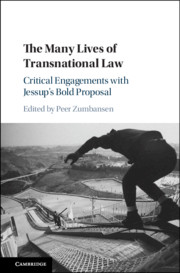Book contents
- Reviews
- The Many Lives of Transnational Law
- The Many Lives of Transnational Law
- Copyright page
- Contents
- Contributors
- Preface and Acknowledgements
- Introduction Transnational Law, with and beyond Jessup
- Part I Transnational Law
- Part II Transnational Law as Regulatory Governance
- Part III Transnational Law
- 13 Locating Private Transnational Authority in the Global Political Economy
- 14 Transnational Law as Drama
- 15 Transnational Law as Unseen Law
- 16 The Cri de Jessup Sixty Years Later
- 17 The Private Life of Transnational Law
- 18 After the Backlash
- Part IV Conclusion
- Index of Names
- Subject Index
16 - The Cri de Jessup Sixty Years Later
Transnational Law’s Intangible Objects and Abstracted Frameworks
from Part III - Transnational Law
Published online by Cambridge University Press: 18 March 2020
- Reviews
- The Many Lives of Transnational Law
- The Many Lives of Transnational Law
- Copyright page
- Contents
- Contributors
- Preface and Acknowledgements
- Introduction Transnational Law, with and beyond Jessup
- Part I Transnational Law
- Part II Transnational Law as Regulatory Governance
- Part III Transnational Law
- 13 Locating Private Transnational Authority in the Global Political Economy
- 14 Transnational Law as Drama
- 15 Transnational Law as Unseen Law
- 16 The Cri de Jessup Sixty Years Later
- 17 The Private Life of Transnational Law
- 18 After the Backlash
- Part IV Conclusion
- Index of Names
- Subject Index
Summary
This contribution considers Jessup’s vision liberated from its grounding assumption that the transnational arises only to deal with the ad hoc situation when other efforts under the law of a state, any state, fails. The Section “Transnational Law as Manifesto” explores the contemporary approach to transnational law and its more radical possibilities. These possibilities are radical not in the sense of requiring a substantial break with the past but in the sense of suggesting the ways in which Jessup’s vision ultimately requires a shifting of perspectives about the relationship of law to the state, the state to the societal sphere, and both to transnational law and the multinational enterprise. The next Section “Jessup’s Big Bang and Beyond” attempts to move beyond Jessup’s core premise of a situational and ad hoc transnational law as a complement to traditional state based law. The last section, “From Transnational Law to the Law of Transnational Spaces,” considers the parallel development of the problem of transnational law and the transnational enterprise. After 60 years, transnational law remains essentially the law of the in-between, and the enterprise remains the object reified as spatial gap filler in the management of economic relations.
Keywords
- Type
- Chapter
- Information
- The Many Lives of Transnational LawCritical Engagements with Jessup's Bold Proposal, pp. 386 - 418Publisher: Cambridge University PressPrint publication year: 2020



